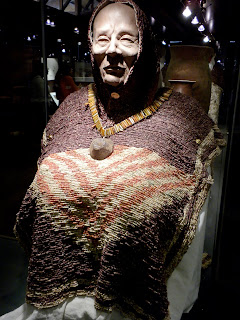Sunday, April 11, 2010
Exploring Quito Again
A week ago I had put together a list that included everything that I had yet to see in and around Quito and throughout Ecuador, and made plans to visit each site on the list. Since I may be leaving early and there is no certainty that I will come back, I realized that I would not be able to see it all, but would try to do as much as possible before I leave.
La Florida Burial Chambers are Quitu structures that date back to 220-640 AD. The Quitu occupied the area around what is now Quito, and of course gave the city its name, which means 'middle of the world'. They knew that they lived in the centre of the world.
I had read about the archeological site, but no one I asked knew anything about it, so armed with the address, I hailed a taxi near Quicentro, and asked him if he knew the place. He waved Maya and I into his cab, and agreed that 'La Florida' was near the airport. He truly had no idea where we were going, so once in the general area, he asked passerbys about the museum. They told him it was way up the hill, past the 'Oriental' (peripheral road). We climbed up the side of the mountain, the car often sputtering in protest, until we asked again and found ourselves dropped off at a modern structure, quite out of place on the side of the hill.
Our guide showed us the ten burial chambers, 15-17 metres deep and 2 metres in diameter. Hundreds of bodies in the fetal position ( the human bodies were given back to Mother Earth's womb) were stacked layer by layer, surrounded by countless ceramic pots, spondylous and other shells, jewelry, wooden objects, and gold. One of the burial chambers was reproduced with 16 bodies and the attendant ritual objects. Wax faces were designed from the skulls via 'forensic medicine' to most closely resemble the Asian- like looks of the early wanderers who came to South America via the Bering Straight.
The most prominent bodies were covered in tunics made entirely of spondylous shells, which were displayed prominently in the small museum on the site. The gold pieces that adorned the bodies, along with pots of all sizes and shapes gave some insight into the burial practices of these people. They believed that the dead returned to Mother Earth, that they needed to bring 'chicha' and food to the other side. They preferred the shape of the circle (life as a circle), but also used thethe cross with earth, water, air, and fire, the triangle and the square in their designs. The Quitu were aware of their location and position in the centre of the world and were good astronomers and appreciated astrology.
The site was well excavated and arranged, and inspired me to see more Quitu art, so we called for a cab (we had arranged for our previous taxi driver to return to pick us up, but he did not show up, so we called another cab who refused to take us to the Centro Historico). I had hoped to see a new museum that was just opening today (the newspaper announced its inauguration), called ' Casa Abbado', which is located in the historical centre near San Fransisco Square. We got out of the cab near the apartment, and caught the Ecovia to La Marin to look for the new museum. It was raining furiously by then, so we bought an umbrella on the street for $2, and tried to walk to San Fransico Square , which is all uphill and felt further on a rainy day. The Museo Abbado was closed to visitors, the inauguration was just for invited guests, so we wandered through the museum which is in the Centro Historico, and visited San Fransico again, as well as the Tanguiz store underneath.
There were few people in the streets and squares, all were huddled under roofs and awnings, wating for the rain to stop, but it did not. Despite the rain and the cold, the city is inviting, and we enjoyed our walk in the rain, amongst the beautiful colonial buildings.
I survived our walk and our ride on the Ecovia. Perhaps I am able to do more than I thought and I can start checking off visits on our list.
Subscribe to:
Post Comments (Atom)

 La Florida Burial Chamber
La Florida Burial Chamber Woman Dressed in Spondylous
Woman Dressed in Spondylous Ecovia Near the Apartment
Ecovia Near the Apartment

 Casa Abbado and Santa Barbara in the Distance
Casa Abbado and Santa Barbara in the Distance Plaza San Francisco
Plaza San Francisco
No comments:
Post a Comment